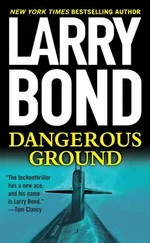As soon as the briefing broke up, Jerry headed forward to control. As navigator, he’d made it his business to look at the chart table at least twice each watch. Yes, they were still in the Atlantic Ocean, with hundreds of miles of water hundreds of fathoms deep below them. Then Jerry imagined how embarrassed he’d be if they ran aground.
QM2 Keith Dunn had the watch. His folks were Georgia farmers, Jerry remembered, and he had five-year-old twins, a boy and a girl. The petty officer was leaning on the chart table, quietly talking with another member of the watch, when Jerry came into control. Dunn quickly turned to the chart table.
“Afternoon, sir.” He pointed to a spot in the chart. The quartermaster reeled off his report with practiced formality. “As of 1330 we’re ninety miles south of Martha’s Vineyard, which is also the closest land. Still on course zero eight zero at sixteen knots, depth two hundred feet. Next planned course change isn’t for two days until after we clear the Grand Banks. It’s going to be a bit dull for us quartermasters, sir.”
Dunn’s report was routine, and Jerry double-checked to make sure he was updating the chart properly. Jerry had watched QM1 Peters take the last GPS fix, just before they submerged, which raised Jerry’s confidence about their location. As long as they were underway, Jerry would be responsible for making sure that Seawolf was where she needed to be, and knowing where she was supposed to go next.
* * *
Driving a submarine was very different from what he’d expected to do in the Navy. Jerry had been selected for aviation and trained as a pilot, and he’d done well. He was short and athletic, with the reflexes and eyesight that flying a fighter demanded. But a tire had blown on takeoff one day, forcing him to eject. He’d made it out of the jet alive, but landed badly, shattering his right wrist. While the doctors had been able to repair the damage, his right hand had “a limited range of motion.”
Those hated words had washed him out of aviation, at least as a pilot. Years of training had been wasted, and the Navy had wanted Jerry to settle for an assignment to surface ships. Jerry was too much a competitor to settle for something offered to him. he’d asked for submarines, another elite branch with a long and difficult entry. The Navy had initially refused. he’d made it, though, using every trick in the book to get the transfer. And he’d made it through nuclear power school and the rest of the submarine training pipeline.
He’d had to adjust. Instead of a single man controlling an agile fighter, he was part of team that controlled a massive underwater machine — a creature of the sea instead of the sky. And while a plane would fly as part of a squadron, a sub always operated alone.
There were similarities, though. Technology made it possible to live and work underwater, just as it let him fly. It let him find and fight an enemy, if he needed to, and the hardware could also kill him if he didn’t stay on top of it. Submariners and aviators both tended to be detail freaks. It was the little stuff that made the difference.
* * *
And practice made perfect. The ship’s 1MC system announced, “SIMULATE UUV LAUNCH OPERATIONS.” Launching and operating a UUV involved only control and the torpedo room watchstanders, but getting the vehicles launched and recovered was going to be critical to the mission. The torpedo division held loading drills every day.
Jerry watched Dunn hook up his sound-powered phones and check communications with the torpedo room. For a real launch, Seawolf had to slow to five knots, and the captain would authorize the UUV’s launch and recovery. And the vehicle’s position had to be plotted, so Dunn monitored the control circuit. For the drill, Dunn would provide control’s responses, but Seawolf wouldn’t actually maneuver.
Jerry wasn’t involved with the loading drill, so he headed aft. There was a mountain of paperwork that he’d put off, and it was all due to the XO before they returned to port. he’d been working only about twenty minutes when the phone buzzed. “Jerry, it’s Greg. Can you come down to the torpedo room?
Lieutenant Greg Wolfe was Seawolf’s weapons officer. He was responsible for the UUVs as well as the sub’s torpedoes and cruise missiles. The two department heads had worked closely on the UUV operational plan for this mission. Jerry’s extensive experience with UUVs aboard Memphis had been very useful during the planning phase. He could tell from Wolfe’s voice that something was seriously wrong.
* * *
Jerry stopped outside the door to the torpedo room. He could hear urgent voices inside, and wondered for half a moment if there was a genuine emergency. Logic answered that question immediately, though. If there had been a real problem, alarms would have sounded minutes ago.
Instead, as he stepped in, alarms went off inside him. Enlisted ratings clustered around the starboard tube nest. The recovery arm, used to bring the UUVs back aboard the sub, was pulled halfway out of its tube back inside the torpedo room.
Cables and equipment clustered around a thick steel beam. Painted a bright green, the recovery arm was designed to fit in a twenty-one-inch-diameter torpedo tube, but just barely. Even though Seawolf’s tubes were larger, they had been sleeved to take the smaller weapons in the U.S. submarine inventory. While the tube was a little over twenty-three feet long, the arm actually expanded out to sixty feet when it was deployed outside the hull.
When a UUV returned to the sub, the recovery arm telescoped out of the uppermost starboard torpedo tube. It had a short-range acoustic homing beacon on the end that guided the underwater robot to within a few feet. Then the arm automatically grabbed the vehicle and lined it up with the torpedo tube below. Finally, it guided the UUV into the tube and retracted back into its own tube. It was as complicated as a Chinese puzzle and as easy to work on as a tax form.
Chief Johnson was directing some sort of activity while Palmer and Wolfe stood in one corner, flipping through tech manuals. Both officers looked up at the same time and saw Jerry. He hurried over to join them, but Wolfe started talking while Jerry was still a few steps away.
“It’s jammed halfway in.” Jerry’s heart sank. He didn’t bother asking how. Wolfe was already explaining.
“We interrupted the loading drill when the recovery arm showed a hydraulic leak. We found the problem and corrected it simply enough, but when we tried to re-stow the mechanism, it only slid part of the way in.
“As we pushed it back into the tube, it made a scraping noise — the kind of sound you don’t want precision machinery to make. When we tried to back it out and look for the cause, it made the same noise, only louder.”
“Did you ever see this on Memphis?” Palmer asked.
Jerry answered quickly, “No. Whenever we worked on the arm, it always went back in smoothly. But the retrieval system and procedures were a lot different since we used a tethered vehicle.”
“It’s like I said, it’s gotta be the tracks.” Palmer was insistent, but then added, “We’re screwed.”
“No we’re not,” Wolfe said firmly. “We’ll sort this out.” He turned to Jerry. “I’ve got Chief Johnson and the division locking it in place so it doesn’t move until we figure out what’s wrong.”
“Losing a vehicle would be bad enough, but losing the arm kills the entire mission. It’s the one thing we can’t replace or work around. We aren’t out even one day and this happens.” Palmer sounded like he was ready to go back to his stateroom and start packing his bags. Jerry thought he sounded frightened, worried more about his career than the jammed arm. Jerry was grateful that they were speaking softly.
Читать дальше












